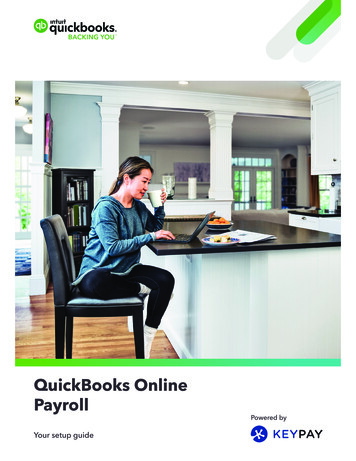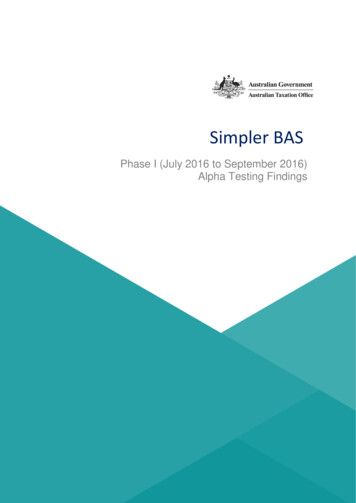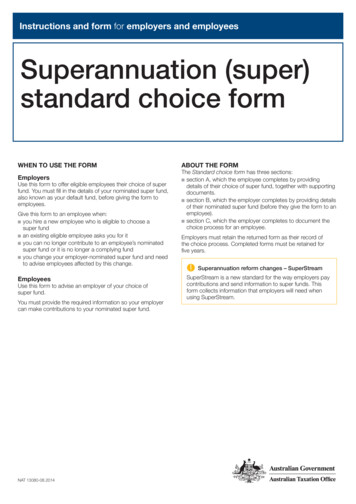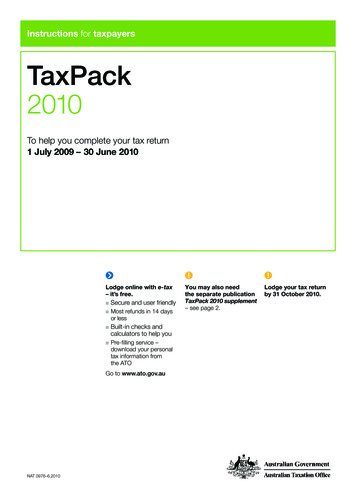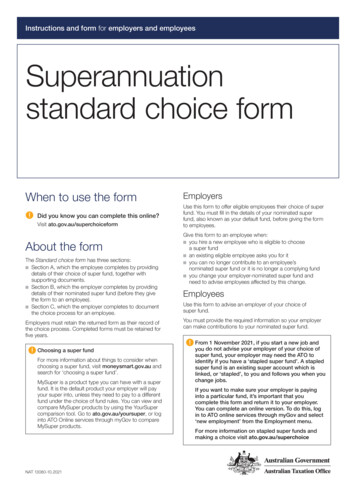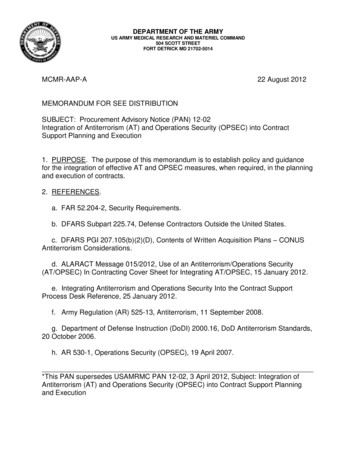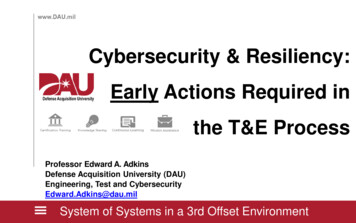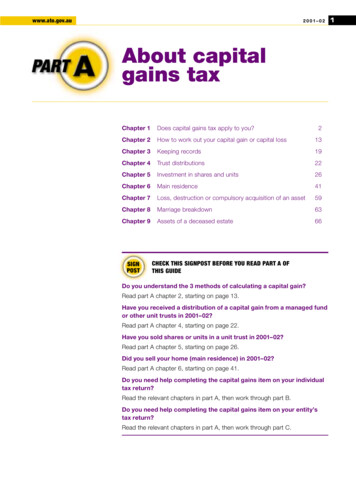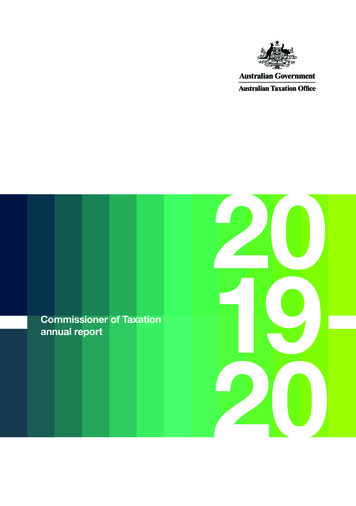
Transcription
Commissioner of Taxationannual report201920
ContactPublishedMailDirectorMeasures, Enterprise Strategy and DesignAustralian Taxation OfficePO Box 9977Civic Square ACT 2608Australian Taxation OfficeCanberra, October 2020NAT 0995-10.2020 DE-23485Phone (02) 6216 1111Email annualreport@ato.gov.auAnnual report ato.gov.au/annualreportWebsite ato.gov.auCopyright AUSTRALIAN TAXATION OFFICE FOR THECOMMONWEALTH OF AUSTRALIA, 2020You are free to copy, adapt, modify, transmit and distributethis material as you wish (but not in any way that suggeststhe ATO or the Commonwealth endorses you or any of yourservices or products).Find ustwitter.com/ato gov cknowledgmentsThank you to all ATO contributors.Designed and editedDigital Experience and Events, ATO Corporate,Australian Taxation OfficePrintedPrinted on Monza Recycled paper that contains99% recycled fibre, and elemental chlorine free pulp.All virgin pulp is derived from well-managed forests andcontrolled sources. Monza Recycled is manufacturedby an ISO 14001 certified mill.
Commissioner of Taxationannual report 2019–20
Commissioner of Taxationannual report 2019–20Commissioner’s reviewIt is my privilege to report on our performance for 2019–20. The year has presented many new andunexpected challenges, but it has also allowed us to demonstrate the vital work we do in serving allAustralians and further validate the community’s trust and confidence in our administration.We started the year with a clear focus on making the ATO a leading tax and superannuationadministration, known for its contemporary service, expertise and integrity. Through 2019–20, we: collected gross tax of around 537 billion, and provided refunds of around 132 billion, with nettax collections of 405 billion – down 21 billion (5%) over the previous year as a result of theeconomic impact of bushfires and COVID-19 delivered a successful Tax Time 2019, receiving over 14 million individual current-year income taxreturns, resulting in over 10.8 million refunds delivered on our government commitments, including through our funded taskforces on corporatetax avoidance, the black economy and serious financial crime completed one of the biggest data migrations ever undertaken in the public or private sector,consolidating data into a single account processing system that provides a whole-of-client accountview for around 17 million accounts improved and streamlined businesses’ interactions with government, by enhancing systems likeSingle Touch Payroll (STP), delivering myGovID and the Relationship Authorisation Manager (RAM)for business, and continuing our work on ABN reforms finalised a secure robust data network that allows Australian businesses to seamlessly exchangeinvoices with suppliers and buyers in over 34 countries supported Australians affected by summer bushfires by facilitating lodgment and paymentdeferrals, and adjustments to pay as you go (PAYG) instalments to alleviate cash flow pressures.Much of this work was completed before the onset of the global COVID-19 pandemic, and from February2020 our priorities and focus shifted: the Australian Government announced a series of escalatingemergency responses designed to slow the spread of the disease, as well as stimulus measures to helpAustralians and the economy withstand and recover from the economic impact of the pandemic.The ATO contributed to the design of several economic stimulus measures, as well as being entrustedto deliver key programs. Staff from across the organisation contributed to our response and rose tomeet the surge in demand for our services. In the first day JobKeeper enrolments opened, we received 170,000 enrolments and more than270,000 logins to our online services using myGovID, on top of our ‘business-as-usual’ demand. In the first day early release of super was available, we received applications from over 315,000individuals. By 30 June, we approved 20 billion to almost 2.5 million individuals. Between March and June 2020, we had answered over 3 million calls – some days this was morethan double the daily call volumes of the previous year. By 30 June, we had paid over 35 billion to businesses through JobKeeper and refunds fromboosting cash flow for employers.II
Much of our ability to deliver these outcomes was due to initiatives we had already implementedas part of our reinvention, which made it easier for the community to quickly access the supportthey needed. As STP was already being used by the majority of employers across Australia toreport salary and wage information, it was key to enabling JobKeeper, and provided a level ofintegrity across the program. The flexibility and intuitive interfaces of myGovID and RAM alsoproved critical, enabling businesses and tax and BAS agents to access a range of stimulusmeasures like JobKeeper and Cash Flow Boost for employers.Our response to COVID-19 also relied heavily on the dedication of our staff and our ability tomobilise, to meet numerous high-level priorities, deliver on new commitments to government,and provide support to Australians experiencing financial hardship. During this period: Over 4,000 staff from across the ATO were temporarily reassigned to answer calls from thecommunity and trained to perform priority tasks like arranging debt and lodgment deferrals. We ensured our staff were as safe as possible, able to stay connected and productive, andkept up to date on changes affecting them. We worked at an extraordinary pace to facilitate remote working; within weeks we had over14,500 staff working from home, including over 1,000 front-line staff from our contact centres. We upheld our high governance and risk management standards to protect the integrity of thetax and superannuation systems and ensure support went to where it was needed most. Our June 2020 staff engagement survey showed strong improvements in employeeengagement, culture and commitment to the ATO.By July and the start of a new financial year, there was a second surge in demand for our services.This included a new round of stimulus applications and payments, and many people lodgingincome tax returns early to access much-needed refunds. By 30 September 2020, we hadreceived over 7.9 million individual current-year income tax returns, and issued over 6.6 millioncurrent-year refunds totalling over 17.2 billion – a decrease of 6% on the same time last year.Our hard work and commitment to put clients at the centre of everything we do did not gounnoticed, with client and community confidence in the ATO increasing significantly over thistrying period.Of course, these accomplishments were not achieved overnight or in isolation. Our ability todeliver through this time of major social and economic disruption is in large part thanks to thecontributions of our stakeholders, as well as our previous work to become a more streamlined,integrated and data-driven organisation.When launching our vision towards 2024, I said the journey would be challenging but worth it.The events of 2019–20 have shown how true that statement was, and it both reinforces andvalidates the importance of our goals in delivering better outcomes for the Australian community.III
Commissioner of Taxationannual report 2019–20Looking forwardThe events of this year have seen the ATO called upon to deliver more, and to do so in new andresourceful ways – this task will only continue in the year ahead. Our role delivering the governmentstimulus measures is ongoing, while upholding our regular services remains vital. As such, we needto think carefully about how we prioritise our work moving forward.To guide the organisation, my Executive team and I have set four key themes for the year ahead: responding to COVID-19 – contributing to Australia’s economic recovery while meetingcommunity expectations of fairness in the system and our administration continuing our transformational journey – building our systems and capability so we can deliverfor the community when it matters most, and simplifying our processes to drive better outcomes continuing to become more streamlined and integrated – improving the way we collect, manage,share and use data to build confidence and drive actions that maximise value establishing the Commonwealth Business Registry Service – simplifying business registrationto make it easier for businesses to interact with government and further unlock the value ofbusiness registry data to support economic growth.There are more challenges on the horizon for the ATO. But whether we are administering the taxand superannuation systems, delivering new measures, helping design new policy, or improving ourservices, the challenges are outweighed by the opportunities.My Executive team and I would like to take a moment to thank the people of the ATO and ourpartners; they have provided an extraordinary level of commitment and service to our clients andorganisation in what has been an extremely challenging year. We have done great things togetherand I look forward to seeing what we will deliver in 2020–21.Chris Jordan AOCommissioner of TaxationRegistrar of the Australian Business RegisterIV
COMMISSIONER OF TAXATIONThe Hon. Michael Sukkar MPMinister for Housing and Assistant TreasurerParliament HouseCANBERRA ACT 2600Senator the Hon. Zed SeseljaAssistant Minister for Finance, Charitiesand Electoral MattersParliament HouseCANBERRA ACT 2600Dear ministersAs the Accountable Authority for the Australian Taxation Office (the ATO), the Australian Charitiesand Not-for-profits Commission (ACNC) and the Tax Practitioners Board (TPB), I present you withthe annual reports for the year ended 30 June 2020 for presentation to Parliament, in compliancewith section 46 of the Public Governance, Performance and Accountability Act 2013.The reports follow the guidelines approved by the Joint Committee of Public Accounts and Audit,as well as other legislative reporting requirements as listed in: sections 17AA to 17AJ of the Public Governance, Performance and Accountability Rule 2014 subsection 60-130(1) of the Tax Agent Services Act 2009 (for the TPB) Division 130 of the Australian Charities and Not-for-profits Commission Act 2012(for the ACNC).Due to their operational independence and statutory obligations, the TPB and the ACNC haveproduced their own annual reports.As required by section 10 of the Public Governance, Performance and Accountability Rule 2014,I certify that we have: prepared fraud risk assessments and fraud control plans appropriate fraud prevention, detection, investigation and reporting mechanisms that meet thespecific needs of the ATO taken all reasonable measures to appropriately deal with fraud.Yours sincerelyChris Jordan AOCommissioner of Taxation andRegistrar of the Australian Business Register2 October 2020Ian Klug AMChairTax Practitioners BoardThe Hon. Dr Gary JohnsCommissionerAustralian Charities and Not-for-profits CommissionV
Commissioner of Taxationannual report 2019–20Contents01 Overview02 Annual performance statement03 Revenue performanceVIIICommissioner’s reviewVLetter of transmittal1About us2Outcome and program structure4ATO client landscape4Our ministers5ATO Executive10Organisational structure11Statement by the Accountable Authority12Program 1.1 Australian Taxation Office47Program 1.2 Tax Practitioners Board48Program 1.3 Australian Business Register52Program 1.4 Australian Charities andNot‑for‑profits Commission53Administered programs 1.5 to 1.1959Revenue collection62Tax performance66Total revenue effects
04 Management and accountability05 Financial statements06 Appendixes71Corporate governance84Workforce management105Financial performance115About the financial statements115Financial statements180 Appendix 1: Laws conferring powers on theCommissioner181Appendix 2: Taxpayers’ Charter –our performance183Appendix 3: Public advice anddispute management187Appendix 4: Legal services expenditure189Appendix 5: Strategic litigation194Appendix 6: Debt management196Appendix 7: Compensation statistics197Appendix 8: Service commitmentsand activities203Appendix 9: Advertising, direct mail, mediaplacement and market research206Appendix 10: Use of access powers207Appendix 11: Information provided to lawenforcement agencies212Appendix 12: Corrections214Reference materialVII
Commissioner of Taxationannual report 2019–20VIII0
01OverviewAbout usOur vision is to be a leading tax and superannuation administrationknown for our contemporary service, expertise and integrityAs a Commonwealth entity within the Treasury portfolio, the ATO is accountable underthe Public Governance, Performance and Accountability Act 2013 (PGPA Act) and thePublic Service Act 1999 (PS Act).Our role and responsibilitiesThe Commissioner of Taxation is responsible for administering Australia’s tax system andsignificant aspects of Australia’s superannuation system. For the purposes of the PGPA Act,the Commissioner is the accountable authority for the ATO, the Tax Practitioners Board (TPB) andthe Australian Charities and Not-for-profits Commission (ACNC). He is also the Registrar of theAustralian Business Register (ABR).The ATO is the Australian Government’s principal revenue collection agency, administering thelegislation governing tax, and supporting the delivery of government benefits to the community.Our roles and responsibilities are set out in more detail, by agency program, on pages 2–3.The TPB and ACNC operate independently of the ATO and each produces its own annual report.Their reports are available at tpb.gov.au and acnc.gov.au, respectively.
01Commissioner of Taxationannual report 2019–20Outcome and program structureIn 2019–20, the ATO had one outcome and was funded to deliver this through four agencyprograms and 15 administered programs. All deliverables for administered programs are achievedthrough making payments to eligible recipients in accordance with relevant laws.ATO outcomeConfidence in the administration of aspects of Australia’s taxation and superannuation systemsthrough helping people understand their rights and obligations, improving ease of compliance andaccess to benefits, and managing non-compliance with the law.Agency programs1.1 Australian Taxation OfficeThe ATO effectively manages and shapes the tax and superannuation systems that support andfund services for Australians, by: collecting revenuemaking it easy for the community to understand and comply with obligationsadministering the goods and services tax (GST) on behalf of the Australian states and territoriesadministering major aspects of Australia’s superannuation system.1.2 Tax Practitioners Board (TPB)The TPB program is delivered through five overarching strategies: Client services – supporting consumers and practitioners in the delivery of tax services,legal and ethically Investigations and enforcement – data-driven compliance activities focusing on high risk andunregistered tax practitioners Law and policy – providing guidance and legal advice to shape the law through litigationand legislation Corporate services – providing a complete and uniform governance framework, includingbudgeting, people, planning, risk assessment, change management, and corporate strategy Technology – supporting business outcomes with digital and information technology (IT) solutionsfor clients and staff, including improved data analytics.While the TPB is included in the ATO program structure and under the ATO outcome, it operatesindependently of the ATO and produces its own annual report. The TPB’s annual report is availableat tpb.gov.au.2
OverviewOutcome and program structure011.3 Australian Business Register (ABR)The ABR program works with government, digital service providers, the business community andother key stakeholders to support a fairer business environment that fosters greater economicgrowth and job creation. This will be achieved through increased use of a trusted national businessdataset and use of consistent information exchange standards.1.4 Australian Charities and Not-for-profits Commission (ACNC)The ACNC effectively manages a regulatory system for the Australian charitable sector by: registering eligible not-for-profit entities as charities in accordance with the Australian Charitiesand Not-for-profits Commission Act 2012 (ACNC Act) and the Charities Act 2013 providing information, guidance and advice about good governance practices and assistingcharities to meet their obligations to maintain charity registration assessing concerns raised about registered charities, investigate where appropriate and initiatecompliance action against charities that contravene the ACNC Act, governance standards orexternal conduct standards working with other government agencies (Commonwealth, state and territory) to reduceunnecessary regulation on charities and align regulatory obligations through various mechanisms,including the ACNC’s Charity Passport.While the ACNC is included in the ATO program structure and under the ATO outcome, it operatesindependently of the ATO and produces its own annual report. The ACNC’s annual report isavailable at acnc.gov.au.Administered programsAdministered programs may be administered by the ATO with policy and delivery assistancefrom other Commonwealth agencies, or directly through the tax and superannuation systems.Our administered programs for 2019–20 were:1.5 Australian Screen Production Incentive1.6Junior Minerals Exploration Incentive1.7Fuel Tax Credits Scheme1.8National Rental Affordability Scheme1.9Product Stewardship for Oil1.10 Research and Development Tax Incentive1.11 Low Income Superannuation Tax Offset1.12Private Health Insurance Rebate1.13 Superannuation Co-contribution Scheme1.14Superannuation Guarantee Scheme1.15 Targeted Assistance Through the Taxation System1.16 Interest on Overpayment and Early Payments of Tax1.17 Bad and Doubtful Debts and Remissions1.18 Other administered programs – Seafarer Tax Offset1.19 Economic Response to the Coronavirus3
01Commissioner of Taxationannual report 2019–20ATO client landscapeThe ATO interacts with a vast number of clients in the community – and each client group hasdifferent requirements and outcomes they seek from the tax and superannuation systems.Figure 1.1 shows the clients we interact with.FIGURE 1.1 ATO client landscape, at 30 June 202011.5 million910,000205,00036,000individuals notin businessemployersnot-for-profitorganisationspublic and multinationalbusiness groups linkedto 84,000 entities4.2 million595,000178,50036,000small businessesincluding sole traderssuper fundsprivately ownedand wealthygroups linked to866,000 entitiesregistered andactive tax andBAS agents593,000self-managedsuper funds220large APRA-regulatedsuper funds1,670small APRA-regulatedsuper fundsOur ministersThe ministers with responsibility for matters relating to the tax and superannuation systems in2019–20 were: The Hon. Josh Frydenberg MP, Treasurer The Hon. Michael Sukkar MP, Assistant Treasurer and Minister for Housing Senator the Hon. Jane Hume, Assistant Minister for Superannuation, Financial Services andFinancial Technology. The minister responsible for the ACNC in 2019–20 was Senator the Hon. Zed Seselja,Assistant Minister for Finance, Charities and Electoral Matters.For more information on our ministers, see ministers.treasury.gov.au.4
OverviewThe ATO Executive01The ATO ExecutiveThe Commissioner is supported by an executive team, with each member having responsibilityfor key aspects of the ATO’s performance.The ATO Executive sets our strategic direction and monitors delivery of our commitments togovernment and the community. Its focus is on strategic matters that relate to the direction andpositioning of the organisation. The Executive also provides leadership, driving the client-focusedculture of the ATO.For more details about our senior leaders, see ato.gov.au/about-ato.The Commissioner of TaxationChris Jordan AO was appointed as the 12th Commissioner of Taxationon 1 January 2013.Chris has broad and lengthy experience in tax policy and law developmentand implementation, having held influential roles in the private sector and asa government advisor to both Labor and Coalition governments.Chris Jordan AO,Commissioner of Taxation andRegistrar of the AustralianBusiness RegisterHe was Chair of the Board of Taxation from June 2011 to December2012 and a member of the Board since its inception in 2000. He alsoserved as Chair of the Business Tax Working Group from 2011 to 2012,and as Chair of the New Tax System Advisory Board (1999 to 2001).He was a member of the Working Group that consulted with the miningindustry about the resource rent tax (2011–12).Chris has diverse experience in the tax and consulting profession.He started his accounting career with Arthur Andersen in 1979, was asenior lecturer in taxation at Sydney’s University of Technology from 1982to 1985, and then worked at KPMG for over 25 years. From 1995 to 2000,he was Partner in Charge of the NSW Tax and Legal Division of KPMG,and from 2001 to 2012 was Chairman of Partners for KPMG NSW.Until taking up his role as Commissioner of Taxation, Chris wasthe Chairman of the Committee for Sydney, a director of the BellShakespeare Company and the Sydney Children’s Hospital Foundation,as well as a member of the Audit and Risk Committee for theNSW Art Gallery.Chris has a Master of Laws (Sydney University) and Bachelor ofCommerce and Law (University of NSW). He is a Fellow of CharteredAccountants Australia and New Zealand, Fellow of the Institute ofCompany Directors and a Chartered Tax Adviser with The Tax Institute.Chris’s term as Commissioner of Taxation and Registrar of the AustralianBusiness Register runs until 29 February 2024.5
01Commissioner of Taxationannual report 2019–20Executive team responsibilitiesJanine Bristow is the Chief Finance Officer, supporting the deliveryof ATO outcomes through efficient and effective investment ofpublic monies.Janine acted in the role from July 2019 and was formally appointedon 8 May 2020. The previous occupant, Frances Cawthra, left theATO on 12 July 2019.Janine Bristow ChiefFinance OfficerJanine leads finance professionals across ATO Finance to deliveron resource management and strategy, budgeting, financialaccounting and tax reporting, procurement and contractmanagement, corporate IT systems, as well as property andportfolio management services.ATO Finance provides the ATO with investment insight, adviceand support, enabling the effective and efficient managementof resources to deliver on organisational strategies andgovernment commitments.Jacqui Curtis, as Chief Operating Officer, is responsible for leadingthe ATO’s Enterprise Strategy and Corporate Operations Group.Jacqui was also appointed the inaugural Head of the APS HRProfessional Stream in October 2019 and was Co-Chair of theATO COVID-19 Steering Committee from March 2020.Jacqui CurtisChief Operating Officer,Enterprise Strategy andCorporate Operations GroupThe role of Enterprise Strategy and Corporate Operations isto ensure we are well positioned for Australian Public Service(APS) wide reforms of corporate and shared services – and thatour people management, communication solutions, planning,governance, finance, risk and change management arestrategic and effective.Jacqui brings together an integrated picture of people and resourcemanagement, ensuring the ATO has the right capability and cultureto deliver on our strategic intent. She plays a lead role in managingrelationships with key stakeholders including scrutineers. All ofthese underpin our ability to deliver a better experience for bothclients and staff.As Head of the APS HR Professional Stream, Jacqui buildsstrategic human resources (HR) capability through initiatives thathelp identify core, long-term capability needs, standards andcareer pathways to support HR professionals in the APS.6
OverviewThe ATO Executive01Kirsten Fish was a member of the ATO Executive from 19 Marchto 30 June 2020 and acted in the role of Second Commissioner ofthe Law Design and Practice Group from 1 April to 30 June 2020.Kirsten had overall responsibility for the ATO’s law practice,including law interpretation, public advice and guidance,independent dispute prevention and resolution, and our role inpolicy and law design.Kirsten FishA/g Second Commissioner,Law Design and Practice GroupThe Law Design and Practice Group contributes to theadministration of the tax and superannuation systems by seeking tomake tax fair, simple and understood. We work collaboratively withTreasury and other agencies in supporting government outcomesand leading the ATO’s work on design of new policies and law.Law Design and Practice is involved at the early stages of adviceand review, providing certainty through interpretation of the law andpublication of guidance to support our clients in getting it right thefirst time.We are committed to understanding the drivers of disputes,litigating only the right cases, and encouraging prevention andensuring earlier resolution where disputes happen.Jeremy Geale was Co-Chair of the ATO COVID-19 SteeringCommittee from 19 March to 30 June 2020 and member of theATO Executive. The role has oversight of internal and externalprocesses to ensure our response to the COVID-19 pandemicis comprehensive and coordinated.The committee was established to provide high level strategicleadership. It ensures we are safeguarding the health and safety ofour staff and protecting our business continuity, so we can continueto deliver services for the community. The committee also providesguidance and advice on the implementation of related governmentmeasures and whole-of-government responses.Jeremy GealeChief Officer, COVID-19ResponsePrior to taking on this role, Jeremy was acting Second Commissionerof the Law Design and Practice Group after Andrew Mills retiredfrom the office of Second Commissioner of Taxation effective31 December 2019.7
01Commissioner of Taxationannual report 2019–20Jeremy Hirschhorn is the Second Commissioner with overallresponsibility for the ATO’s Client Engagement Group, which fosterswilling participation in Australia’s tax and superannuation systemsthrough well-designed client experiences. Jeremy acted in the rolefrom December 2018 and was formally appointed on 16 April 2020.Jeremy HirschhornSecond Commissioner,Client Engagement GroupAcross all client experiences – from the very largest public andmultinational businesses to small businesses and individuals –the Client Engagement Group uses insights from client interactionsto help design a tax system that makes it easier to comply, andharder not to. The group supports the integrity of the tax andsuperannuation systems by addressing non-compliance, andensures increasing transparency about the operation of the systemfor taxpayers and key partners.The group also plays an important role in working with theinternational tax community. Through collaborating with otherjurisdictions, the Client Engagement Group improves the way taxadministrations work together to address arrangements used toevade and avoid tax.Ramez Katf is the Second Commissioner with overall responsibilityfor the Enterprise Solutions and Technology Group, and the ATO’sChief Information Officer.Ramez provides leadership and strategic direction to modernisingthe revenue collection system and contributing to the government’sbroader digital agenda.Ramez KatfSecond Commissioner,Enterprise Solutions andTechnology Group8Enterprise Solutions and Technology ensures we are takingadvantage of the most innovative trends in technology to improvethe experience of ATO staff and the community. This role hasbecome increasingly important in balancing expectations anddemand as new technology solutions continue to emerge.
OverviewThe ATO Executive01Melinda Smith, as Chief Service Delivery Officer, has overallresponsibility for the Service Delivery Group.This part of the ATO is responsible for a broad range of the ATO’sfoundation services for all segments of the community. These includeprocessing payments, activity statements, income tax returns,superannuation lodgments and other forms, as well as administeringthe tax file number register, Australian Business Register and registersheld on behalf of the superannuation industry.Melinda SmithChief Service Delivery Officer,Service Delivery GroupThe group focuses on working with ATO clients to understand theirneeds. It offers a tailored approach to help them meet their obligationsas easily as possible through contemporary tools, systems andservices. It also engages with clients on a large scale and uses astrategic early intervention approach to educate them and influencewilling participation.The group is leading or contributing to a number of transformationalinitiatives for government. It works closely with other areas of the ATOto improve the experience for clients and drive greater efficiency andquality outcomes. The focus on better use of data, digitisation andbuilding a strong service culture ensures the ATO is well positionedfor the future.9
010Commissioner of Taxationannual report 2019–20Organisational structureThe ATO is structured in five groups, each reporting to a member of the ATO Executive. Each groupconsists of a number of business areas.FIGURE 1.2 ATO organisational structure, at 30 June 2020Commissioner of Taxation andRegistrar of the Australian Business RegisterChris Jordan AOClient EngagementGroupSecond CommissionerJeremy HirschhornLaw Design andPractice GroupSecond CommissionerKirsten Fish (acting)Service Delivery GroupChief ServiceDelivery OfficerMelinda SmithEnterprise Solutionsand Technology GroupSecond CommissionerChief Information OfficerRamez KatfEnterprise Strategyand CorporateOperationsChief Operating OfficerHead of APS HRProfessional StreamJacqui CurtisSuperannuation andEmployer ObligationsDeputy CommissionerJohn Ford (acting)Policy,
annual report 2019-20 II Commissioner's review It is my privilege to report on our performance for 2019-20. The year has presented many new and unexpected challenges, but it has also allowed us to demonstrate the vital work we do in serving all Australians and further validate the community's trust and confidence in our administration.
